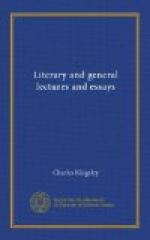And so for mother earth, as for the rest, the best representation of the divine was the human. Now, conceive such an idea taking hold, however slowly, of a people of rare physical beauty, of acutest eye for proportion and grace, with opportunities of studying the human figure such as exist nowhere now, save among tropic savages, and gifted, moreover, in that as in all other matters, with that inmate diligence, of which Mr. Carlyle has said, “that genius is only an infinite capacity of taking pains,” and we can understand somewhat of the causes which produced those statues, human and divine, which awe and shame the artificiality and degeneracy of our modern so-called civilisation—we can understand somewhat of the reverence for the human form, of the careful study of every line, the storing up for use each scattered fragment of beauty of which the artist caught sight, even in his daily walks, and consecrating it in his memory to the service of him or her whom he was trying to embody in marble or in bronze. And when the fashion came in of making statues of victors in the games, and other distinguished persons, a new element was introduced, which had large social as well as artistic results. The sculptor carried his usual reverence into his careful delineation of the victor’s form, while he obtained in him a model, usually of the very highest type, for perfecting his idea of some divinity. The possibility of gaining the right to a statue gave a fresh impulse to all competitors in the public games, and through them to the gymnastic training throughout all the states of Greece, which




